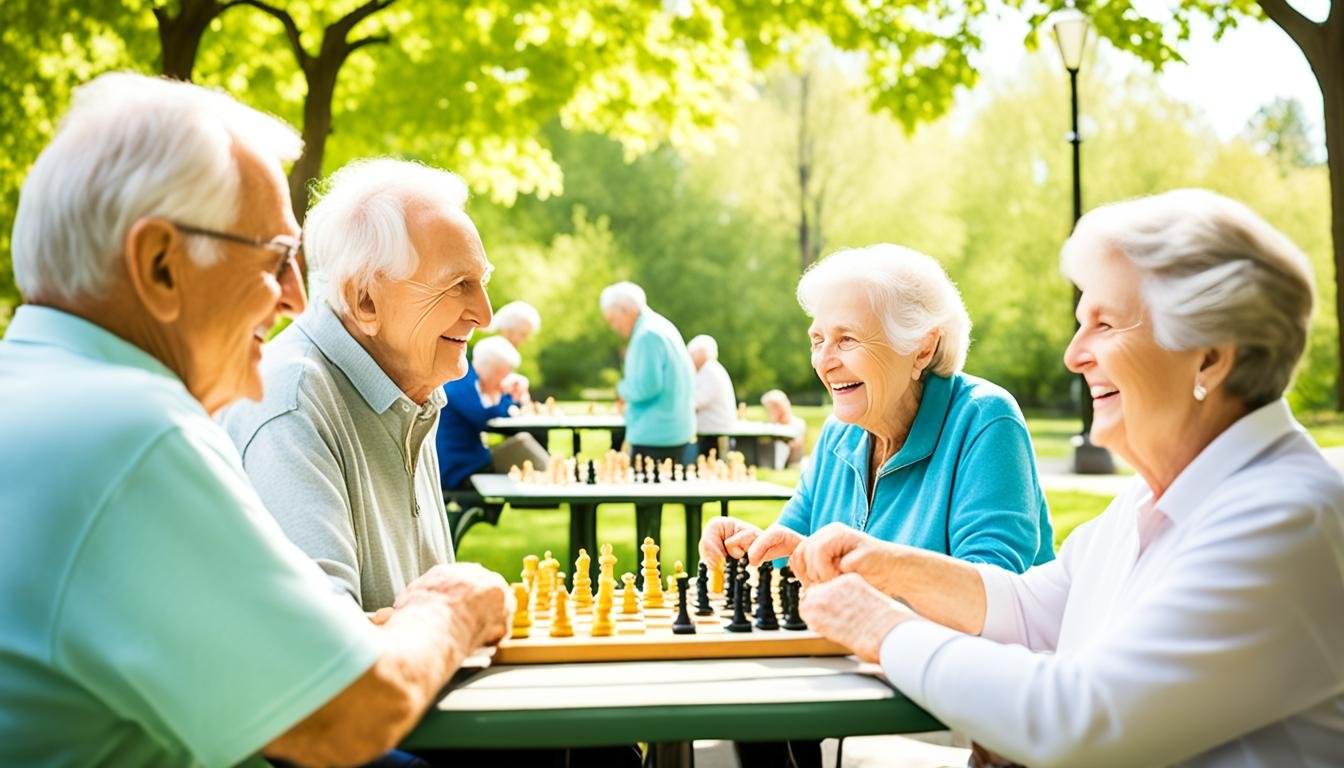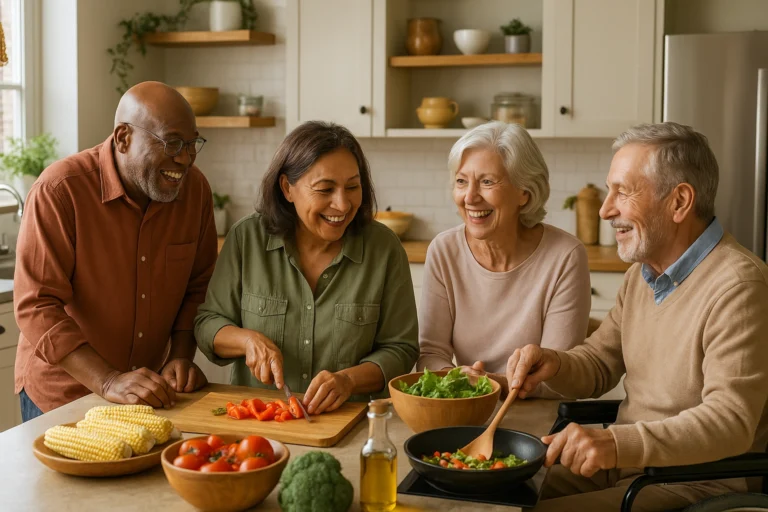It’s common for seniors to feel left out and alone, but staying connected is key to happiness and health. Do you want to know the best ways to keep you or your loved ones active and happy in their community? Let’s explore.
Key Takeaways
- Understand the impact of social isolation on seniors and the importance of social connections for their health.
- Distinguish between loneliness and social isolation, and learn how to address both effectively.
- Explore various strategies to keep seniors socially active, from joining exercise groups to embracing lifelong learning opportunities.
- Discover how technology can help seniors stay connected and engaged with their communities.
- Overcome common barriers to social engagement, such as mobility and transportation challenges.
Understanding the Impact of Social Isolation on Seniors
Social isolation and loneliness are big concerns for older adults in the U.S. The National Academies of Sciences, Engineering, and Medicine say over a third of adults 45 and up feel lonely. Almost a quarter of those 65 and older lack social connections.
The Centers for Disease Control and Prevention say loneliness is feeling alone. Social isolation is not having enough social connections. Both can harm the health of older adults. They increase the risk of stroke, heart disease, dementia, and early death.
Statistics on Loneliness and Social Isolation Among Older Adults
The COVID-19 pandemic made senior loneliness worse. Many older adults felt more isolated because of social distancing and restrictions. A study by the AARP Foundation found more older adults felt lonely often, going from 22% in 2018 to 36% in 2020.
- More than one-third of adults aged 45 and older feel lonely.
- Almost one-quarter of people aged 65 and older are socially isolated.
- During the COVID-19 pandemic, the percentage of older adults reporting frequent loneliness increased from 22% in 2018 to 36% in 2020.
It’s important to help older adults with social connections. This keeps them healthy and happy. By understanding social isolation and helping them connect, we can ensure they stay active and engaged in their later years.
The Difference Between Loneliness and Social Isolation
Knowing the difference between loneliness and social isolation is key for seniors. These two terms are often used together but mean different things.
Loneliness is feeling alone, even if you’re around people. It’s about not having deep connections or relationships. Social isolation, on the other hand, means not having many social interactions. This can make someone feel lonely.
So, someone can be alone a lot but not feel lonely. Or, someone with lots of friends might still feel lonely. The main point is that loneliness is a feeling inside, while isolation is about being alone on the outside.
“Loneliness and social isolation are not the same thing, but they are closely related. Loneliness is the subjective feeling of being alone, while social isolation is the objective state of having few social relationships or interactions.”
Knowing the difference helps us help seniors better. It lets us know how to support their social needs. By understanding loneliness and isolation, we can make our help more effective.
The Importance of Social Connections for Seniors’ Health
For older adults, strong social connections are key to their health and happiness. Research shows that not having friends can really hurt their physical and mental health. This can lead to many bad outcomes.
Risks Associated with Lack of Social Connections
Studies link not having friends to a higher risk of heart disease, metabolic syndrome, high blood, pain, tiredness, trouble sleeping, feeling sad, and more. Not having friends is as bad as eating poorly, not moving much, drinking too much, and smoking.
Feeling alone and lonely can really harm seniors’ health and happiness. It’s important to keep up with friends to help seniors stay healthy in body and mind, which also lowers the risks of feeling alone.
| Health Risks Associated with Social Isolation | Potential Consequences |
|---|---|
| Cardiovascular Disease | Increased risk of heart attacks, strokes, and other cardiovascular problems |
| Metabolic Syndrome | Higher risk of diabetes, high blood pressure, and obesity |
| Hypertension | Elevated blood pressure levels, increasing the strain on the heart |
| Depression and Dementia | Increased risk of developing mental health issues and cognitive decline |
| Premature Mortality | Higher chances of early death, similar to the risks of unhealthy behaviors |
“Maintaining social connections is crucial for promoting the physical and mental health of seniors.”
The proof is clear: social connections are vital for seniors’ health. Older adults can live better lives by focusing on staying connected and avoiding isolation.
How to keep seniors socially active
Seniors need to stay socially active. Doing so helps them fight loneliness and live a happy life. Here are some ways to keep seniors connected and active in their communities.
Join Exercise Groups and Classes
Exercise is good for health and offers seniors a chance to meet people. Please encourage them to join groups like low-impact aerobics, yoga, or dance classes. These activities improve fitness and help seniors make friends and feel part of a community.
Volunteering and Giving Back
Volunteering is a great way for seniors to be active and help others. Please encourage them to find volunteer work that matches their interests and skills. This could be tutoring kids, helping at charities, or cleaning up the community. Volunteering keeps seniors busy, gives them purpose, and makes them feel like they belong.
Lifelong Learning and Intellectual Pursuits
Keeping the mind sharp is key for seniors. Please encourage them to take classes, attend lectures, or join book clubs. These activities keep their minds active and offer chances to meet new people and share ideas.
Utilizing Technology for Social Connections
Technology is a big help in keeping seniors connected today. Encourage them to use social media, video calls, and online groups that match their interests. These tools let seniors stay in touch with family, join online activities, and discover new hobbies.
By trying these ideas, seniors can stay busy, fight loneliness, and live a full social life. Supporting senior social activities is important for their happiness and well-being.
Strategies for Promoting Social Engagement
It’s vital to keep seniors active and connected. Joining senior exercise groups is a great way to do this. These groups help seniors stay fit and build strong social ties.
Group social fitness activities are a hit with seniors with many options, like:
- Dance classes that mix fun moves with social time
- Walking clubs for enjoying nature and talking with friends
- Organized sports teams for teamwork and fun rivalry
Participating in these group activities boosts physical health and fights loneliness. Seniors share interests and make lasting friendships, keeping them feeling part of a community.
“Exercise programs for older adults can be a great way to stay physically active while also fostering social connections.”
Pushing seniors to try these senior exercises and social activities is smart. It keeps them active and connected with others.
Volunteering and Giving Back to the Community
Volunteering can be a fulfilling way to stay active and engaged when you reach your golden years. It lets you use your skills and time for a cause you believe in. This can give you a sense of purpose and happiness in retirement.
Seniors have many volunteering options, from helping charities to working on community projects. These activities help you meet new people, learn new things, and make a difference in your community.
A study by the Corporation for National and Community Service found that seniors who volunteer feel happier, have less depression, and are healthier. Helping out can keep you mentally well and connected as you retire.
“Volunteering is the ultimate exercise in democracy. You vote in elections once a year, but when you volunteer, you vote every day about the kind of community you want to live in.”
– Unknown
By volunteering, you can find new purpose and happiness in retirement. It’s great for both you and your community. You get to help others and stay active and connected.

| Benefits of Senior Volunteering | Examples of Volunteer Opportunities |
|---|---|
|
|
Lifelong Learning and Intellectual Pursuits
Continuing your education and engaging in intellectually stimulating activities can be a gateway to a more fulfilling and vibrant life as you enter your golden years. Pursuing senior education and cognitive stimulation can keep your mind sharp and connect you with like-minded individuals. This fosters a sense of community and purpose.
There are always opportunities for lifelong learning. You can find technology training, online university courses, and educational programs tailored for seniors. By exploring these resources, you can challenge your brain, acquire new skills, and discover new passions. All while enhancing your overall well-being.
| Lifelong Learning Opportunities | Benefits |
|---|---|
| Technology Training | Improve digital literacy and stay connected |
| Online University Courses | Engage in intellectually stimulating coursework |
| Educational Activities | Discover new interests and connect with peers |
Embracing continuing education and intellectual pursuits can be a transformative experience. It empowers you to maintain a sharp mind, foster social connections, and unlock a vibrant life after 60. Explore the wealth of learning opportunities available and embark on a lifelong growth and fulfillment journey.
“The more you learn, the more you’ll earn.” – Benjamin Franklin
Utilizing Technology for Social Connections
Today, technology is a vital tool for seniors to stay connected. It offers many ways to keep them engaged, like social media, video calls, and online communities. These tech solutions help seniors who can’t meet up in person.
Social Media, Video Calls, and Online Communities
Seniors can use Facebook, Instagram, and Twitter to talk with friends and family. These social media sites let them share news, photos, and messages. This helps them feel connected. Video calls through Skype and FaceTime also let them talk face-to-face, even if they’re far apart.
Online communities, which are websites or social media groups, are great for those looking to meet others with similar interests. Seniors can join discussions, ask questions, and get support from others who understand their challenges.
The SeniorThrive app and ecosystem allow users to connect with other users to discuss independent living at home. This includes topics such as hobbies, home decor, home safety, and connecting with others who are also thriving as they grow older.
By using technology, seniors can overcome physical barriers and keep up with friends and family, which helps them feel better and live fuller lives.
Overcoming Barriers to Social Engagement
Keeping an active social life is key for seniors’ well-being. Yet, some seniors face challenges that make it hard to stay connected. Understanding and tackling these barriers is important to helping our loved ones.
Addressing Challenges Such as Mobility and Transportation
Mobility and transportation issues are big hurdles for seniors. Those who have trouble moving or don’t have a way to get around can’t easily go to social events or see friends. This makes it tough to participate in community activities, too.
To overcome these senior social barriers, work with your loved one to determine what they need. This could mean setting up transportation for seniors, such as ride-sharing, public transport, or volunteer drivers. Sometimes, it’s about finding social activities at home or online to promote accessibility and keep them connected.
By tackling these issues, you can help your senior loved one join in on social activities. The strategies in this article can guide you.
| Barrier | Potential Solution |
|---|---|
| Mobility Issues | Arrange for transportation for seniors, such as ride-sharing services, public transportation, or volunteer driver programs. |
| Lack of accessibility | Find in-home social activities or virtual engagement opportunities to promote accessibility and ensure your loved one can stay connected. |
Conclusion
Keeping seniors socially active is critical for their health and happiness. It’s important to know how social isolation affects them. By finding ways to help them connect, we can ensure they have a strong support network.
This article has shown how to keep seniors connected and active. It offers steps for both seniors and caregivers to focus on social interaction. Seniors can join groups, volunteer, or use technology to stay engaged.
Seniors must have social connections for a good life. By supporting their social lives, we can greatly improve their aging experience. Let’s keep finding ways to keep our seniors active and connected, step by step.
FAQ
What are the statistics on loneliness and social isolation among older adults?
A recent report from the National Academies of Sciences, Engineering, and Medicine (NASEM) found that over a third of adults 45 and older feel lonely, and almost one-quarter of those 65 and older are socially isolated.
What is the difference between loneliness and social isolation?
The CDC says loneliness is feeling alone, even with lots of social contact. Social isolation is not having enough social connections. These two are related but not the same thing.
What risks are associated with a lack of social connections for older adults?
Research shows not having social connections is bad for older adults. It can lead to heart disease, metabolic syndrome, high blood pressure, pain, fatigue, insomnia, depression, dementia, and even dying early.
What are some effective strategies for keeping seniors socially active?
There are many ways to keep seniors active, like joining exercise groups or classes. Volunteering, lifelong learning, and using technology to connect with others are also good options.
How can technology help seniors stay socially connected?
Technology like social media, video calls, and online groups helps seniors meet new people. It’s great for those who can’t easily go out for social events.
How can caregivers and loved ones help seniors overcome barriers to social engagement?
Caregivers and loved ones should discover what barriers their senior faces, like mobility or getting around issues. Then, they can look for ways to help them join in on social activities.
Source Links
- https://seniornavigator.org/article/77382/12-ways-older-adults-stay-socially-connected – 12 Ways for Older Adults to Stay Socially Connected
- https://www.healthline.com/health-news/staying-social-as-a-senior – Why It’s Important to Stay Social as You Age – and 5 Ways to Do It
- https://www.ncbi.nlm.nih.gov/pmc/articles/PMC7233208/ – Strategies to Promote Social Connections Among Older Adults During “Social Distancing” Restrictions



